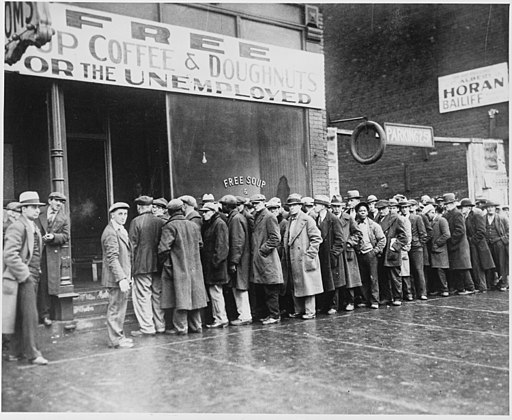It will take more than a Presidential address for America to relearn that when it comes to economic policy, we need to put markets and property first.
Class Homicide

Massive inequality and the rise of a new feudal system have nearly destroyed the chances of social mobility.
The following essay is an excerpt from a longer item published as part of the Provocations series by the Center for the American Way of Life.
There’s much talk today, from left and right, about threats to democracy, yet little focus on the social dynamic critical to its survival. In this respect, we may see the current, and troubling, escalation of violent political rhetoric, and even political violence, not so much as the cause of polarization but the result of changing class dynamics, most notably the increasingly perilous state of the yeoman middle class.
The United States, and much of the high-income world, is going through a revision of class relations resonant with gilded age, or even feudal models. A recent British parliamentary study projects that by 2030, the top one percent will expand their share to two thirds of the world’s wealth, with the biggest gains overwhelmingly concentrated at the top one percent of the top one percent—the top 0.01 percent.Similarly, in this country, since the mid-1980s, the share of national wealth held by those below the top 10 percent has fallen by 12 percentage points, the same proportion that the top 0.1 percent gained.As one conservative economist put it succinctly in 2018, “The economic legacy of the last decade is excessive corporate consolidation, a massive transfer of wealth to the top 1 percent from the middle class.”
Hierarchy triumphs over merit and even luck
In the process, the aspirational character long essential to American society is being transformed. According to one study, the chances of middle-class earners moving up to the top rungs of the income ladder has declined by approximately 20 percent since the early 1980s. Data from the Census Bureau show that the share of national income going to the middle 60 percent of households has fallen to a record low.
In the economy, hierarchy is rapidly replacing opportunity. Banking and finance, treated amiably by Washington during the Financial Crisis, have become increasingly concentrated while many smaller regional institutions have either been acquired or driven out of business. Growing corporate concentration has now seeped into the once dynamic tech economy in both the U.S. and Europe. In Silicon Valley now, the renowned garage culture has morphed into a Gargantua of giant firms with market power unprecedented in modern times, controlling in some cases 80 to 90 percent of key tech markets.
Similarly, property ownership has become more concentrated; we see declining homeownership, particularly among the young, notably in the United States, Canada, and Australia. One analyst predicted that soon most middle class people will be “priced out” of ownership in a “rentership society” where Wall Street firms profit by renting homes, furniture, and other necessities.
Own nothing and eat it
Increasingly, property ownership now increasingly depends on inheritance; the offspring of property-owning parents are far better situated to own a house eventually (often with parental help) and enter what one writer calls “the funnel of privilege.” In America, millennials are three times as likely as boomers to count on inheritance for their retirement. Among the youngest cohort, those ages 18 to 22, over 60 percent see inheritance as their primary source of sustenance as they age.
The assault on middle class mobility strikes at the heart of democratic governance. Throughout history, democracy, the definition of which clearly changes over the millennia, has rested on a broad base of small property owners—merchants, artisans, skilled laborers, small farmers, and professionals. The earliest democracies in Athens and Rome rested on an assertive property-owning middle class. Aristotle also warned about the dangers of an oligarchy that would control both the economy and the state; in fact, an ever-greater consolidation of wealth played a role in undermining Greek democracy. Much the same process took place in the once citizen-led Roman Republic. By the end of the Republic, over 75 percent of all property was owned by roughly 3 percent of the population, while over four-fifths owned no property.
The revival of democracy in the early modern period occurred largely in countries—notably the Netherlands, Britain, and later North America—that spawned a rising middle class. Medieval economics depended on rentiers and inheritors, but the changing conditions elevated innovative, aggressive, risk-taking entrepreneurs. New technology, expanding trade, and institutions of self-government transformed feudal society. The entrepreneurs who chipped away at the feudal order did not generally come from the nobility, who in some cases were prohibited or socially discouraged from engaging in commerce. Aristocratic elites did sometimes give valuable funding and sponsorship to entrepreneurs, many of whom were from groups that had long been persecuted, including itinerant workers and dissenting Protestants, as well as Jews.
The key here was a shift from aristocratic and ecclesiastical domination of landownership to a more “individualistic” concept of property rights. A substantial class of independent smallholders demanded a constitutional order that would protect their holdings. Artisans and merchants had laid the groundwork for self-governance within their guilds, and in some places seized power from the aristocracy and even the clergy. As the radical social theorist Barrington Moore said a half century ago, “no bourgeois, no democracy.” Or, to alter Aristotle a bit, no middle class, no political liberty.
Initially the Industrial Revolution heightened class conflicts through what Karl Marx described as “naked, shameless, direct brutal exploitation.” Yet even as industrialization engendered horrific inequality, a study covering the United Kingdom, the Netherlands, and the United States shows that all three saw a rapid decline in the concentration of wealth from the 1820s up to the 1970s. The decades after the Second World War were particularly good for the middle orders. Between 1940 and 1950, the incomes of the bottom 40 percent of American workers surged by roughly 40 percent, while the gains in the top quintile were a modest 8 percent and the top 5 percent even saw their incomes drop slightly.
Just the way things work
Our current drift back towards hierarchy has many roots, among them the influence of technology, inattention to monopoly (under both parties), the pandemic, and addressing climate change. This is not so much a “conspiracy,” but the collective result of private actions driven by rational decision-making. Yet there has been a marked decrease in the percentage of all small firms in both the United States and Europe as larger firms continue to increase their share of the economic pie.
Technology has played a critical role in driving business from the Main Streets and local companies toward massive firms with the ability to adjust to changing conditions.This was particularly evident during the pandemic, where the restrictions and forced closings clearly favored big companies, who could deploy greater resources to transition to the new reality. Big pharma, meanwhile, has scooped up lucrative profits with vaccine revenue.
As executive compensation reached the stratosphere at the big tech and finance firms, the Harvard Business Review notes that small businesses—the bulwark of the yeoman class—face “an existential threat” to their existence. Roughly 110,000 restaurants have shut down during the lockdowns, and some 200,000 more businesses overall disappeared compared to the usual erosion. Barely 16 percent of small business owners, according to one recent survey, think the federal government is performing well for them.
These same businesses may now face a greater long-term threat from climate regulations, which are certain to increase costs and regulatory burdens. For climate activists, the extreme Covid measures constituted not emergency measures but a “test run” for imposing their preferred energy use policies.These approaches tend to hurt the working and middle classes far more than either the professional clerisy or the oligarchs, as they explicitly oppose upward mobility. Yet it would be an exaggeration to say that mass immiseration is their intention—it’s just the result of their theology and, to some extent, their insulation from the world of analog commerce, factories, trucking, or farming.
The decline of the yeoman class sets the stage for future political conflict. Small business—that part of the middle class not tied to government—has continued to struggle and has become a critical component of the contemporary populist movement brought into focus by Trump. Yet at the same time, many younger people, including the children of the middle class, facing bleaker prospects, look increasingly to the socialist state to provide for them. Each component has increasingly little stake or faith in the current political system.
We face a crisis not just of political faith, but belief in the economic system itself. Yet the situation is not hopeless. During the pandemic, many Americans reinvented themselves as entrepreneurs, launching a whole crop of new startups, many embodying the shift to online work. In 2021, after years of decline, new business formation increased dramatically.Americans have also voted with their feet, heading from dense, usually highly regulated regions to suburbs, exurbs, and smaller towns, where they seek to find a more affordable way of life, and the chance of achieving a middle class standard.
Credo expertam
The growing readiness of people to question the priorities of their betters, widely rebuked in the media, actually represents a hopeful sign. Recent surveys have shown an historically low level of confidence in U.S. institutions—from Congress and the courts, to large corporations and Wall Street.The CDC achieved almost mythical authority early in the Covid pandemic, but it has since lost the trust of a wide majority of Americans and is now undergoing a large-scale reappraisal of its public messaging. Protests over Covid lockdowns sprang up across the world, with particular vehemence in Canada of all places, though based on questionable anti-vax ideologies, also revealed a healthy measure of skepticism and a willingness to speak out rather than docilely submit to the powerful and the expert class.
It won’t be the upper classes who drive the resistance to autocracy and neo-feudalism because they largely benefit from the current economic structure. The initiative must come from the grassroots, in organized or ad hoc groups that challenge the domination of their betters. Right now, neither party focuses on key class issues—concentration of wealth and property, the impact of government regulation on small businesses—because it interferes with their own political constituencies. For Republicans, the issue remains the sanctity of capital in all cases, which reflects the party’s continued reliance on wealthy donors.The Democrats may talk about inequality but under the Clinton and Obama administrations allowed monopolistic tech firms to merge and buy out competitors with impunity.
Democrats, as Thomas Frank notes in The Guardian, reject the very notion of “populism” and favor a “grand vision of how society should be directed” through the agency of “responsible professionals” like themselves. University of California Professor Joan C. Williams, author of Overcoming Class Cluelessness in America, notes that Democrats “once focused on good jobs for a very broad range of Americans that yielded their version of a solid, middle-class life,” but now, rather than boost the economic basis of social democracy, have “been offering them sympathy and social programs.”
Ultimately, the party or ideologies that address inequality and the squeeze on the middle class will benefit from anti-establishment sentiment. Americans, including minorities, are not wedded to laissez faire religion, as evidenced by Florida’s endorsement of a $15 an hour wage.Yet at the same time, notes one study, barely 8 percent of the population can be considered “woke,” and this small group is mostly white, well-educated, and affluent.
We have to hope that most Americans, of all races, do not want a new feudalism, oppose the current consolidation of wealth and power, and want greater opportunities for their children. The yeomanry may be down, but they are far from being buried permanently. The potential for a renewal of democratic self-governance is not yet extinguished.
Just as feudalism gave way to the Renaissance and then the growth of democracy, and just as the fall of the Soviet empire birthed free and prosperous nations on its periphery, a democratic renewal is possible today. “Happy the nation whose people have not forgotten how to rebel,” wrote the British historian R. H. Tawney. We just need the courage to insist on more responsive governance and the will to develop a more open, entrepreneurial society, rather than meekly genuflect to political and economic overlords.
The American Mind presents a range of perspectives. Views are writers’ own and do not necessarily represent those of The Claremont Institute.
The American Mind is a publication of the Claremont Institute, a non-profit 501(c)(3) organization, dedicated to restoring the principles of the American Founding to their rightful, preeminent authority in our national life. Interested in supporting our work? Gifts to the Claremont Institute are tax-deductible.
He himself is perfectly capable of unmaking our regime.
Seismic economic and demographic changes will feed division and conflict.



